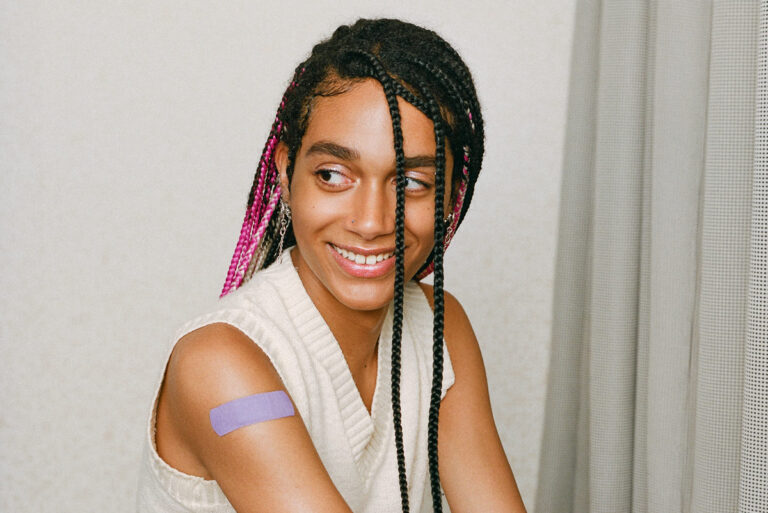Does windmilling your arm after getting a COVID-19 vaccine help prevent soreness? TikTok thinks so
If you spot TikTokers flailing their arms in the parking lots of vaccination centres, you would probably think they’re onto some new workout trend or dance routine. What if I told you that they’re trying to hack their way through one of the most common vaccine-related symptoms instead? Introducing ‘windmilling’, a post-vaccine TikTok trend that involves channelling your inner Michael Phelps before heading home with your vaccination card.
What is TikTok’s windmilling trend?
Windmilling refers to the circular rotation of your arms in a manner suggestive of the rotating sails or vanes of a windmill. On TikTok, the movement is guaranteed to help prevent or alleviate arm soreness, one of the most common symptoms of the COVID-19 vaccines.
“Fully vaxxed, you know what that means,” reads the title of a TikTok video as the user proceeds to windmill her arms aggressively. With ‘Too Player’ by Vinny West playing in the background, TikTokers are often seen recording themselves in the bathrooms and parking lots of hospitals and vaccination centres—all because “TikTok said so.”
@hannah_leeee fully vaccinated✅
♬ Too Player by Vinny West - RyanKanta
So, does it actually work?
According to a bunch of medical experts interviewed by The Guardian, the only thing windmilling your arms in public will alleviate is your dignity.
“It’s harmless, looks very silly and won’t do anything,” said Beate Kampmann, director of the Vaccine Centre at the London School of Hygiene & Tropical Medicine. In the interview, Kampmann explained how arm soreness is not an immediate symptom of the vaccine, nor does everyone get it either. Adam Finn, professor of paediatrics at the University of Bristol and an honorary consultant at the Bristol Royal Hospital for Children, agreed to these claims. “I doubt it is harmful—or helpful beyond any placebo effect, which could be substantial,” he said.
A spokesperson for AstraZeneca said that they were “unable to rule anything out” in terms of whether the movement might help reduce post-jab soreness, but they were “certainly not aware of it being helpful.” Pfizer and Johnson & Johnson, on the other hand, said there was not sufficient scientific evidence for them to be able to comment in the first place. Professor Saad Shakir, director of the Drug Safety Research Unit, additionally questioned why TikTok users “didn’t just take a paracetamol if their arms hurt.” He also added on to the potential of windmilling being done in randomised, controlled trials instead of all at once.
Speaking about “controlled trials,” Doctor Abisola Olulade, a San Diego-based physician, actually recommends windmilling—but not the way TikTok suggests. “When you get a vaccine your immune system creates a reaction in your body, and it causes inflammation at the site of the vaccination,” she explained in an interview with Refinery29. “That is what leads to the soreness and the pain.” According to the doctor, moving your arm around essentially allows blood to flow freely to that area—which in turn encourages those inflammatory molecules to move away from the injection site. “It helps to prevent the soreness from being concentrated in that one area,” she added.
The doctor, however, warns against aggressive movements of the freshly-vaccinated arm altogether. This is because aggressive jerks could cause hypertension if done repeatedly throughout the day. Then there is the entire possibility of smacking your arm against something—for which you would need another hack to alleviate the soreness.
@reaganelisee i was laughing so hard making this #vaccinated #covid19 #pfizergang #pfizer #getvaccinatedyall
♬ Too Player by Vinny West - RyanKanta
What can you do instead?
According to Athletico Physical Therapy, a few stretches and exercises can help alleviate arm soreness following your COVID-19 jab. The list includes seated towel slides, shoulder posterior and circle pendulum stretches as well as flexion wall slides. These exercises are often recommended in sets of three spanning 30 seconds at the most. It is also essential to exercise within your own limits and contact your healthcare provider if the side effect lingers for more than a few days.
A few pre-vaccine tips to keep in mind in relation to arm soreness include getting the jab on your non-dominant arm, avoiding muscle tension during the injection and applying ice or a warm compress after. Timing your vaccine appointment also buys you a timeframe to recover before returning back to work without putting additional stress on your arm.
Be it for the placebo effect or vaccine clout, TikTok’s obsession with windmilling may just be a relatively harmless one, compared to the increasing list of bizzare COVID-19 hacks. According to some medical experts, windmilling might have an unexpected positive outcome. “If it raises awareness of the jab and makes it seem like a joyful, playful thing, then that’s a very good outcome to the dance,” said Azeem Majeed, head of the Department of Primary Care & Public Health at Imperial College London. “Let people wave their arms if it makes anyone feel better,” Kampmann added in the interview with The Guardian.
With the minimum age for vaccinations reducing as we speak, it is only a matter of days before more vaccine trends start popping up on the gen Z-dominant platform. So brace yourself for more VaccineTok videos and remember to do your due research—because some might not be worth the shot.





